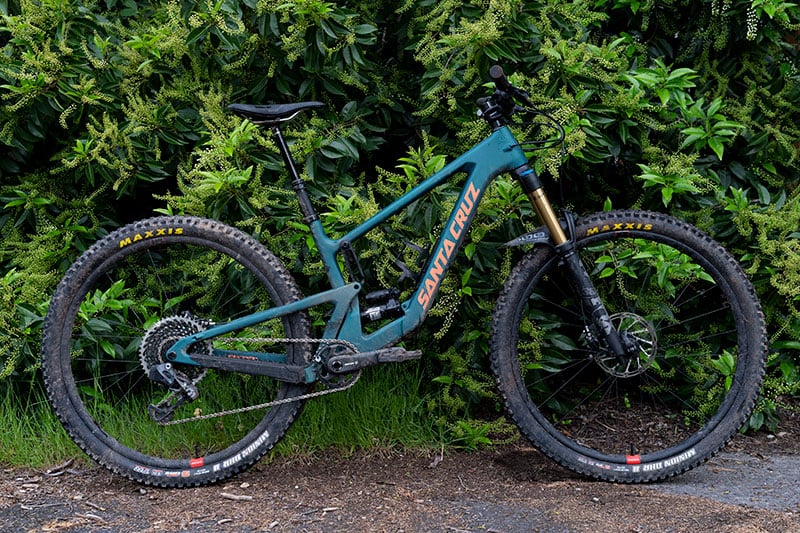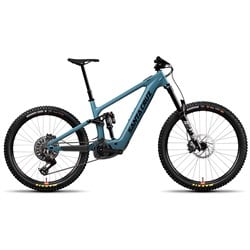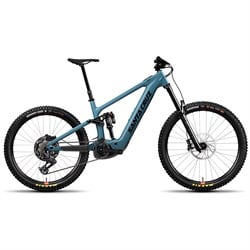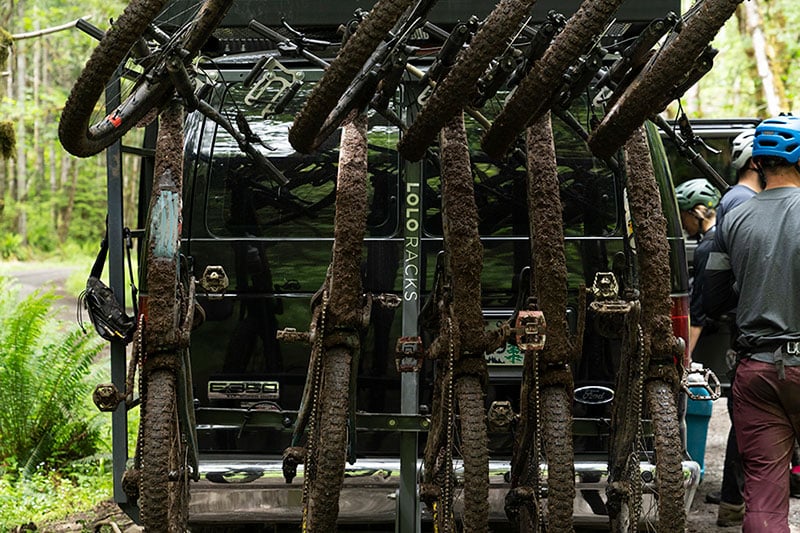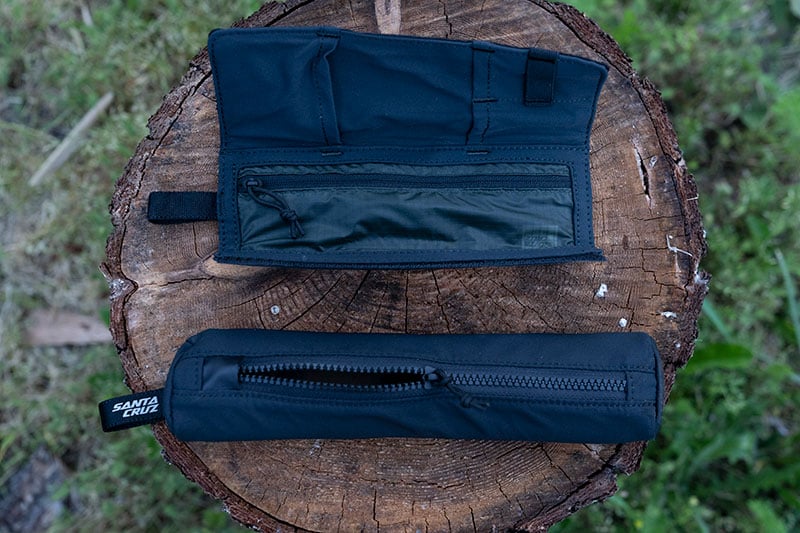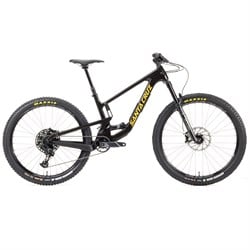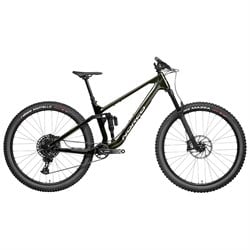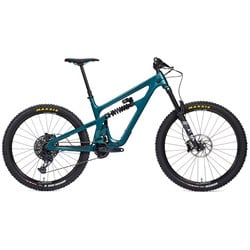2023 Santa Cruz Hightower Review
By: Danielle Vilaplana | June 22, 2022
We’ve all heard the tale of the “quiver killer” - the soft-flexing twin snowboard that will deftly drop off backcountry ridgelines and the 27.5 downhill rig that can keep up with the gravel racers. It’s a mythical being that I’m inclined to think doesn’t exist but the industry keeps on touting, and every once and a while there’s a glimpse of this jack-of-all-trades.
The V3 Santa Cruz Hightower just might be it. I rode the Hightower for three days in Oakridge, OR, with an impeccable team from Santa Cruz and Trans Cascadia Excursions. It was the sloppiest terrain I’ve ever ridden and featured far more bench cuts and switchbacks than I’d prefer, but the Hightower handled it all with aplomb.
We didn’t climb extensively but what climbing we did was through such slow and sticky dirt we might as well have climbed 10,000ft. Though Oakridge is not particularly technical, there were just enough drops, jumps, and deceptively deep puddles to put the suspension upgrades to the test. Some might call the terrain undulating, which is excellent turf for a trail bike.
Key Details
| 29" Wheels | Glovebox™ Internal Storage |
| 145mm Lower Link Driven VPP Rear Travel / 150mm Fork | Evolved Geometry |
| Chainstay Length and Seat Tube Angle Matched to Frame Size | Lowered Bottom Bracket |
| Increased Stack | Size-specific Frame Stiffness |
| Sizes: S, M, L, XL, XXL | Lifetime Warranty on Frame & Bearings |
Technical Details
Geometry
Here’s a bomb that no one predicted so hold on to your seat - the new Hightower is longer, slacker, and lower. “Refined, not redefined,” as Santa Cruz puts it. The glamor of mountain biking is in the fast descents and stylish airtime that make up for the unflattering inseams and tanlines, so the trend makes sense. But several features distinguish the Hightower from the list of long and low bikes, and many of the standard features remain, like the 29” wheels, 150mm fork and 145mm rear travel, LO/HI Flip Chip, and the VPP suspension.
One of the bigger changes to the Hightower is in the size-specific measurements. Few bike brands had varying chainstays lengths in 2021 so the change is refreshing. Santa Cruz also created new stiffness standards for each size by tailoring the front triangle flex proportionally to frame size. These changes allow smaller riders and bigger riders to all experience the same feel and ride characteristics that Santa Cruz intended for the Hightower, a move that is a little more inclusive to bikers of every height and weight.
The 64.5-degree headtube angle is slacker than its V2 predecessor and the wheelbase increased by 5-10mm, making the Hightower even more stable and speedy on the descents. The seat tube angle continues to vary by size but hovers between 76.7 and 77-degrees, and the stack saw a significant increase by up to 15mm. Reach stayed just about the same, growing just a mere 2mm, and the bottom bracket dropped another 2mm. Together, these changes make for a more comfortable ride that is a little more efficient on the climb and solid on the descent. If that sounds like marketing jargon and you’re tired of reading it, rest assured that I’m tired of writing it, and only through personal riding experience can I say that statement holds some water.
Suspension
Santa Cruz’s lower link VPP suspension is known for being particularly effective at climbing and descending but it received a few kinematic changes for the V3 Hightower. The primary change is in the anti-squat, or the force that your drivetrain creates to combat your weight shifting and compressing the shock as you pedal. Santa Cruz reduced the anti-squat, which doesn’t particularly help the pedaling but that’s not such a big deal in a bike with a relatively high anti-squat and little sag to begin with. It does reduce the effect of the chain pulling on the suspension though, meaning you’ll get better compression on the descent.
Builds
The Hightower comes in six carbon and two aluminum models in sizes S-XXL, so there’s a whopping variety and price discrepancy in the lineup. The carbon models feature some frame variation, as you can choose between Santa Cruz’s C or CC frames for a slight difference in weight and price.
The not-yet-released aluminum builds are significantly more budget-friendly and Santa Cruz didn’t slap on SRAM SX components and call it a day, so there seems to be a solid level of thought and respect that went into each build for the aluminum framers out there.
I had the privilege of riding the Hightower CC X01 AXS RSV and it was truly excellent, even though it features a level of components I have no business riding. I can’t say that I enjoy SRAM’s rocker paddle shifter and would gladly reach for the regular GX models, but more discerning and technologically-inclined riders will appreciate the snappy shifting of the AXS drivetrain.
The build quality is par for the course, with attention to the tiniest details that definitely inspire faith in the brand. For example, the addition of a small window that makes it easier to check your sag will be extremely useful for those who need to dial their suspension for every ride. The Hightower also features smart cable routing to help out your local mechanic and I’ve heard that the design on the top tube says “this is a mountain bike” in morse code, which is the kind of insignificant but affectionate design feature that I love to see.
Features
This is the second Santa Cruz bike to feature integrated storage, following the Megatower release a few months ago. The new Glovebox™ gives access to the space inside a rather impressive downtube, where a Tool Purse and a Tube Wallet organize whatever you’d rather carry inside your bike than out. A tensioned aluminum latch keeps everything secure without rattling, and internal routing is kept separate. Knowing where all your stuff is, that it’s clean and dry, and that it’s staying put: that’s worth its weight in gold.Ride Impressions
Climbing / Uphill
Though the trails in Oakridge are mostly downhill, there were steep, sodden inclines to reach most of the trails from the drop off points as well as punchy climbs throughout the descents. The sticky terrain made the climbing significantly harder compared to my usual dry and dusty Utah trails, but the fact that I didn’t have to walk up every climb is a testament to the Hightower’s pedaling prowess.
Santa Cruz steepened the seat tube and reduced the anti-squat but still kept it fairly high to improve pedaling efficiency and support while climbing. I don’t think the seat tube angle is as noticeable to someone my height, as I’ve enjoyed climbing more on my slightly slacker Kona Process 134 CR/DL since returning home, but I’d expect taller riders to observe a difference.
The higher anti-squat was evident, however, with plenty to push into to get up some of the smoother climbs. I normally flip the climb switch on my Process’ RockShox Super Deluxe Ultimate, but I didn’t feel the particular need to do so on the Hightower because it was already supportive enough!
Descending / Downhill
Santa Cruz can steepen the seat tube and tweak the suspension to call this a climbing bike but there’s no denying that the Hightower thrives on the descent. Though it is certainly enduro-esque, with its slackened head tube and longer wheelbase, it still maintained the fun and nimble characteristics I expect of a trail bike. This may be partially due to the Medium I was riding as opposed to my usual Large, but after many thousands of feet of descent I still wanted to pop off jumps and roots.
The Hightower never missed a beat on the deeper compressions and the reduced anti-squat proved useful on the descents as well, as it muted some of the chatter of smaller bumps. While Oakridge wasn’t all that technical, there were enough drops and bumps to verify that the Hightower does indeed stay as predictable and supportive as advertised.
Overall Impression
Light and nimble bikes are my ride of choice but the Hightower has me wondering what I could do with a little more travel. It holds speed well, whether you’re descending steep trails or pumping over rollers and it kicks off features with ease. It climbs well enough for a trail bike that is pretty enduro-leaning and the suspension upgrades are supportive whether you’re rolling with or pushing against gravity. My only quibble isn't with the bike, but the unfamiliar, confidence-shattering conditions in Oakridge, and I’d love to give it another whirl on some of my regular haunts.
Pros
Size-specific Chainstays and FramesThis is a feature I would love to see from more brands, particularly because I feel like it affects smaller female riders the most. Building bikes the same for everyone makes mountain biking more inclusive and fun for all.
The Glovebox™
Formerly wasted space, the storage room inside your frame is perfect for carrying essentials on shorter rides. It is not big enough for most pumps, however, so riders may need to find alternative solutions or make their buddy carry the pump.
Fillmore Valves
I’m not fully sold on the Fillmores yet, as they are effectively useless without the cap and I’d wager that all five of my bikes are missing caps. But I like where their head is at for tubeless riding and I think other riders will appreciate it too.
Cons
180mm RotorsAt 5’9 and 130lbs, there is not much of a difference between 180mm and 200mm rotors for me. But larger rotors would certainly be appreciated by bigger riders given the 'enduro' direction a lot of trail bikes are going.
Coil Compatibility
Coils have never held much interest to me but after spending some time on Reddit I found a fair amount of complaints that the V2 Hightower couldn’t fit a coil. People predicted that V3 would fix this problem much like the Megatower, but I’m afraid there will be some disappointed folks out there.
Maxxis EXO Casings
I tend to believe that if you’re going to rip a sidewall, it doesn’t matter if you have the lighter or more durable tires. But after our group had five flats in one section, I’m inclined to think that the EXO+ might be the way to go.
The Bottom Line
The new Santa Cruz Hightower 3 is perfectly on trend and it’s hard to say no to a bike with so much versatility. The Hightower stays true to its intended purpose with a little more of everything you’d want in the most demanded bike category: more energetic, more stable, more fun.
Just a few small geometric and suspension tweaks increased its climbing proficiency while simultaneously pushing its downhill performance into the realm of a more playful enduro rig. It may be a little more enduro-leaning but it is still a trail bike the core, a bike that just about anyone will enjoy. Whether you’re pedaling from your front door or filling up the rig for a road trip with your two-wheeled steed, the Santa Cruz Hightower can get you where you want to go.
About the Reviewer
Name: Danielle Vilaplana
Job Title: Copywriter
Age: 29
Height: 5'9"
Weight: 130 lbs
Size Reviewed: Medium
Riding Style: Like a Midwesterner.

2023 Santa Cruz Hightower Geometry
| Size | S (Lo /Hi) | M (Lo/Hi) | L (Lo/Hi) | XL (Lo/Hi) | XXL (Lo/Hi) |
| Reach (mm) | 427 / 430 | 452/ 455 | 472 / 475 | 492 / 495 | 517 / 520 |
| Stack (mm) | 613 / 611 | 627 / 625 | 636 / 634 | 654 / 652 | 668 / 665 |
| Head Tube Angle (°) | 64.5 / 64.8 | 64.5 / 64.8 | 64.5 / 64.8 | 64.5 / 64.8 | 64.5 / 64.8 |
| Seat Tube Length (mm) | 380 / 380 | 405 / 405 | 430 / 430 | 460 / 460 | 500 / 500 |
| Bottom Bracket Height (mm) | 339 / 342 | 338 / 342 | 338 / 342 | 338 / 342 | 338 / 342 |
| Bottom Bracket Drop (mm) | 34 / 31 | 34/ 31 | 34 / 31 | 34 / 31 | 34 / 31 |
| Wheelbase (mm) | 1183 / 1183 | 1218 / 1217 | 1245 / 1244 | 1276 / 1276 | 1311 / 1310 |
| Chainstay Length (mm) | 432 / 431 | 435 / 434 | 438 / 437 | 441 / 440 | 444 / 443 |
| Head Tube Length (mm) | 100 / 100 | 115 / 115 | 125 / 125 | 145 / 145 | 160 / 160 |
| Top Tube Length (mm) | 572 / 571 | 600 / 599 | 627 / 626 | 648 / 647 | 675 / 674 |
| Seat Tube Angle (°) | 76.7 / 77 | 76.7 / 77 | 76.4 / 76.7 | 76.6 / 76.9 | 76.7 / 76.9 |
| Standover (mm) | 701 / 706 | 703 / 708 | 706 / 711 | 709 / 714 | 714 / 719 |

